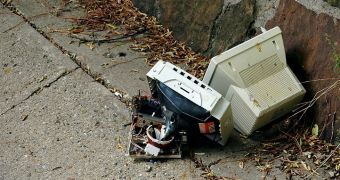The US Environmental Protection Agency (EPA) recently took an extra step in reaffirming its dedication to fighting the problem of electronic wastes at an international level. On Sunday, May 1, it signed a cooperative agreement with the United Nations University.
The signing of this document essentially raised its international involvement in this matter. E-wastes have been a growing problem for years, and authorities in the developed world have until now largely left this problem unchecked.
Millions of computers, TV sets and cell phones are headed for the waste dumps of Africa and Asia, and especially China and India. Here, they being “processed” by extremely poor workers, mostly children, who inhale the toxic chemicals the wastes produce when burnt.
The scavengers burn these materials because they contain traces amounts of gold, platinum, and other dangerous chemicals, that can then be sold for profit. Such behaviors are becoming an increasingly-difficult-to-manage public health problem.
By signing the new document, the EPA has agreed to take a firmer stance – both domestically and abroad – in curbing the unsustainable use of natural resources, in helping manage the rising threat of pollution, and it helping international actors deal with the health problems that stem from this.
Under the provisions of the document, EPA will award the UNU Institute for Sustainability and Peace (UNU-ISP) with a 5-year, $2.5-million grant, that will help investigators keep track of e-waste shipments leaving the United States.
The country is the primary exporter of such waste, but most of the transports it sends out are illegal, and do not respect any type of international agreement on the matter. Some environmental groups have already exposed the fraud, and now authorities are stepping in to handle the issue.
“Currently, most discarded consumer electronics end up in our landfills or are exported abroad, creating potential health and environmental hazards and representing a lost opportunity to recover valuable resources such as rare earth minerals,” US President Barack Obama said in November 2010.
A large portion of the amounts of tin, indium, palladium and cobalt that can be found in electronic devices being thrown to the dump can be extracted and reused, especially now that the rare-Earth element crisis is beginning to pick up.
All of this could be accomplished by better end-of-life management, EPA believes. This is the main reason why it decided to begin its long-term collaboration with UNU.
“We are honored to partner with the EPA to advance research, share knowledge and promote innovative approaches to solving the e-waste problem in developed and developing countries alike,” says the rector of UNU, UN Under Secretary General Konrad Osterwalder.
“All too often today, unwanted electronics wind up among regular household trash, leading to health-threatening incineration or wasteful land-filling,” he adds.
“The rapid pace at which electronic products are being replaced compels all countries to find effective ways to cope responsibly with their e-waste and recover the valuable resources within,” the official goes on to say.
His point of view was echoed by Michelle DePass, the EPA assistant Administrator for the Office of International and Tribal Affairs.
“The electronics that improve our everyday lives often end up discarded in developing countries where improper disposal can threaten local people and the environment,” the official says.
“EPA recognizes this urgent concern and is committed to working with domestic and international partners, such as UN University's StEP Initiative, to address issues related to e-waste,” she adds.
“EPA is pleased to be a leader of a US government task force on electronics stewardship, alongside the White House and our General Services Administration, to develop a strategy and steps for the public and private sectors to manage electronics in ways that safeguard human health and the environment,” DePass concludes.

 14 DAY TRIAL //
14 DAY TRIAL //